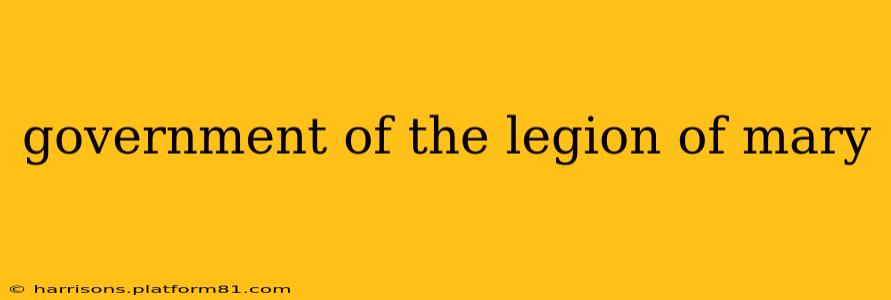The Legion of Mary, a lay Catholic organization dedicated to the evangelization and sanctification of its members and the world, operates under a specific hierarchical structure. Understanding this governance is key to comprehending its global reach and effectiveness. This post will delve into the governmental framework of the Legion of Mary, addressing common questions and providing a comprehensive overview.
What is the governing body of the Legion of Mary?
The Legion of Mary's governing body is a complex, multi-layered structure. At the apex sits the Concilium Legionis Mariae (C.L.M.), or the Council of the Legion of Mary, the supreme governing body. It's based in Rome and oversees the entire organization worldwide. Below the C.L.M., regional and national councils mirror the structure, ensuring consistent adherence to the Legion's spiritual and operational guidelines. Local units, called praesidia, form the grassroots foundation, the core operational units engaging directly with the community.
What are the different levels of the Legion of Mary hierarchy?
The Legion of Mary’s hierarchical structure can be visualized as a pyramid. The hierarchy includes:
- Concilium Legionis Mariae (C.L.M.): The highest governing body, overseeing the entire organization globally.
- Comitia: Regional councils overseeing several countries or dioceses.
- Senatus: National councils supervising the Legion's activities within a nation.
- Regia: A council overseeing several Senatus. This level exists in large countries or regions with many active members.
- Curia: A council responsible for the Legion's activities within a large diocese.
- Praesidium: The basic unit of the Legion, the local group that carries out the practical work of evangelization and spiritual growth.
Each level reports to the level above it, ensuring centralized coordination while allowing for localized adaptation to specific needs and contexts.
How does the Legion of Mary make decisions?
Decision-making within the Legion of Mary follows a hierarchical process, with proposals and directives flowing from the C.L.M. down to the praesidia. Local praesidia contribute their experiences and suggestions to higher councils, allowing for a bottom-up input on practical matters. However, final decisions generally rest with the higher-level councils, ensuring consistency and adherence to the Legion's spiritual guidelines.
Who are the leaders of the Legion of Mary?
Leadership roles within the Legion of Mary vary at each level. Generally, councils are led by a Comitium Director, Senatus Director, or Curia Director. Praesidia have a Praesidium President, Vice-President, Secretary, and Treasurer. These roles are typically filled by committed Legionaries who have demonstrated leadership capabilities and a deep understanding of the Legion’s spirituality and mission. The C.L.M. is headed by a Director General who oversees the global organization.
What is the spiritual basis of the Legion of Mary’s government?
The Legion of Mary's structure and governance are deeply rooted in its spirituality. The organization emphasizes humility, obedience, and the importance of spiritual direction. Decision-making processes aim to reflect these values, prioritizing prayer and spiritual guidance in all organizational matters. Its reliance on spiritual direction and a strong emphasis on prayer are essential components of its governing philosophy. Decisions are made through consultation and prayerful deliberation, ensuring alignment with the Legion's spiritual aims.
Is the Legion of Mary a centralized or decentralized organization?
The Legion of Mary possesses a unique blend of centralized and decentralized elements. The C.L.M. provides centralized guidance, ensuring doctrinal unity and consistent application of the Legion's rules and spiritual principles. However, the structure also allows for considerable decentralization, enabling local praesidia to adapt their activities to the specific needs of their communities. This balance allows for both global unity and local responsiveness.
The hierarchical structure of the Legion of Mary, while seemingly complex, ensures its effective operation on a global scale while maintaining its focus on its foundational purpose: the evangelization of the world and the spiritual growth of its members. Understanding its governance is essential to appreciating its influence and reach within the Catholic Church and beyond.
